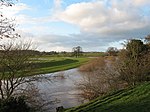Helperby

Helperby is a village and former civil parish, now in the parish of Brafferton and Helperby, in North Yorkshire, England, about five miles west of Easingwold. Over the years it has joined onto Brafferton. Helperby has the Millennium Village Hall, a butcher's shop, a doctor's surgery and a mobile bakery and post office (open only on specific days). There are two pubs, one a restaurant with rooms, one a village inn, and a disused Methodist Chapel which is now a house. In 2008 Helperby had a new pavilion at the football and cricket pitch. There is also a war memorial, in memory of war soldiers in World War One There is also an annual beer festival held in September to raise funds for future development of a Children's play area. The film The Life and Crimes of William Palmer was filmed in the village in 1998. There is now a Children's play area, located outside the Millennium Village Hall, next to the post office. In 2022 a Wedding Event venue was opened, located in the gardens of Helperby Hall.
Excerpt from the Wikipedia article Helperby (License: CC BY-SA 3.0, Authors, Images).Helperby
Drury Lane,
Geographical coordinates (GPS) Address Nearby Places Show on map
Geographical coordinates (GPS)
| Latitude | Longitude |
|---|---|
| N 54.123055555556 ° | E -1.3294444444444 ° |
Address
Drury Lane
Drury Lane
YO61 2PJ , Brafferton and Helperby
England, United Kingdom
Open on Google Maps










